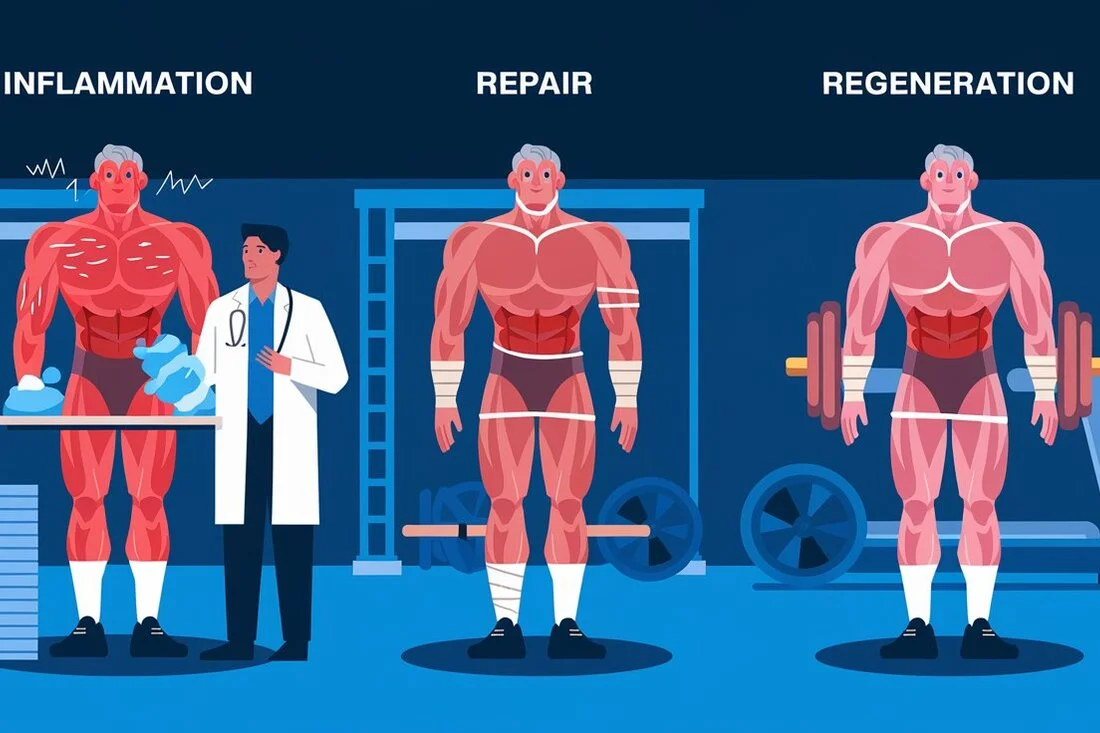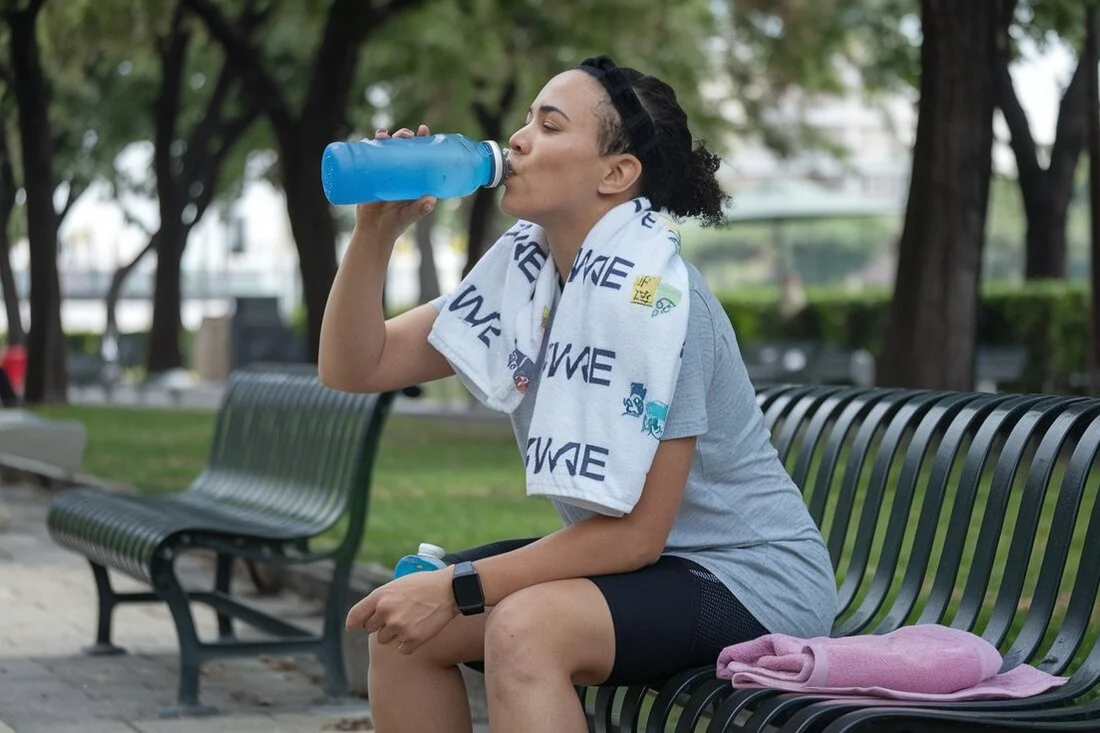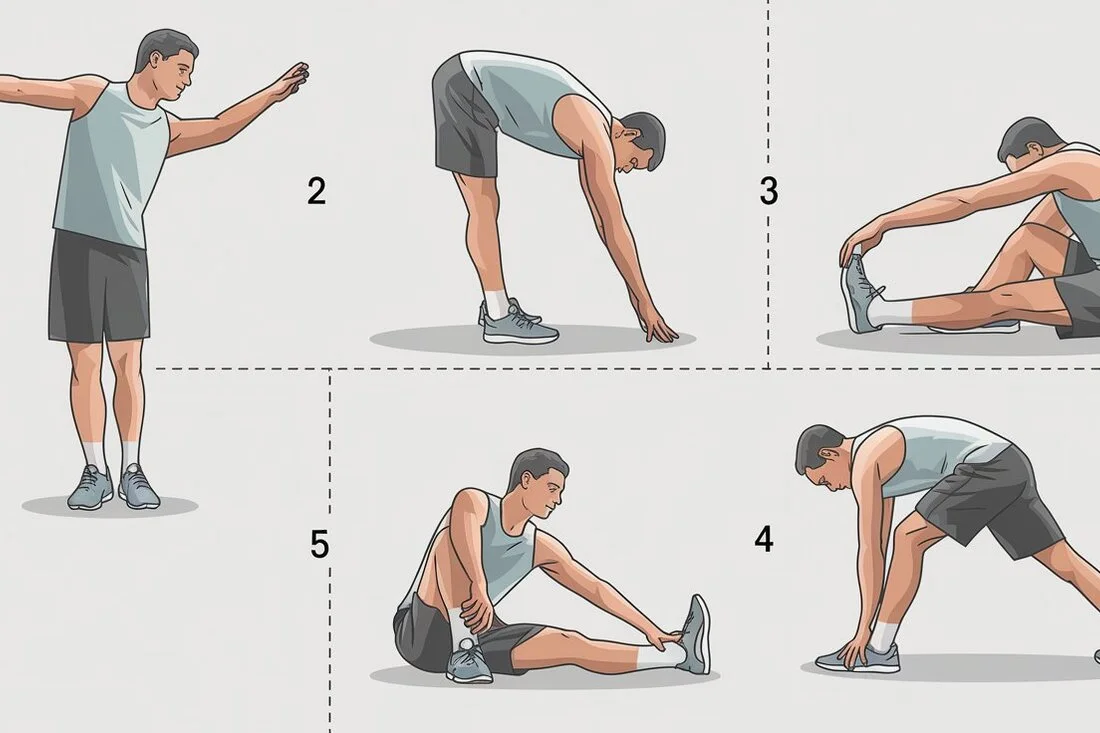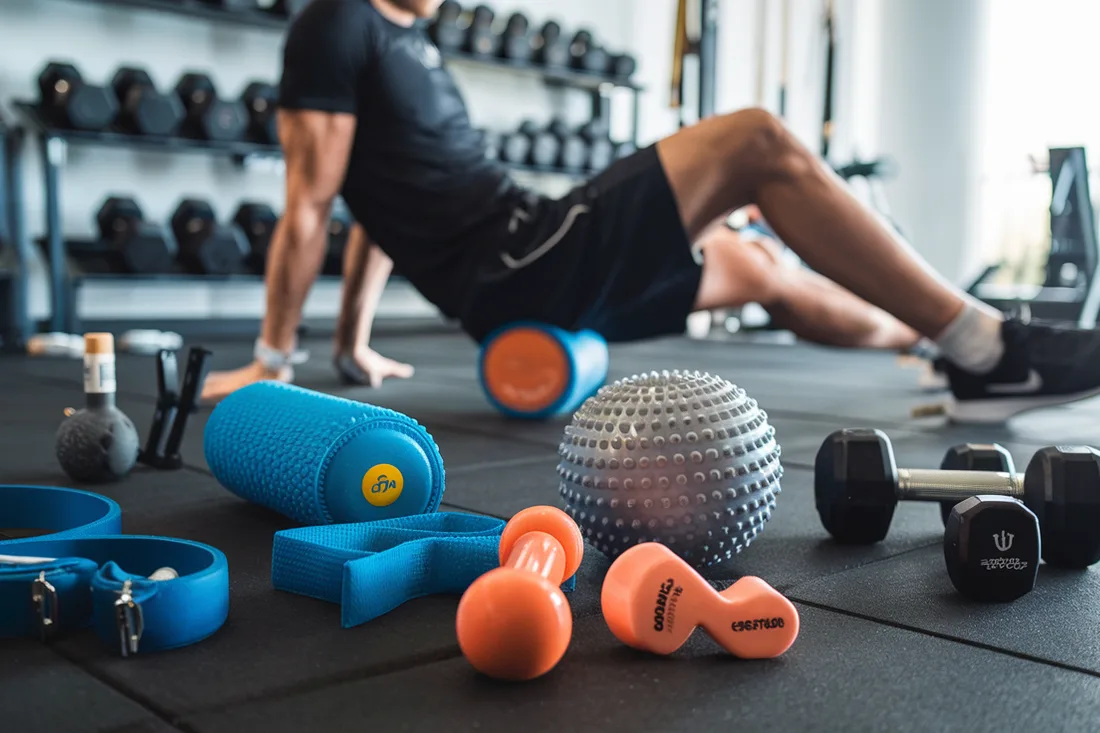Optimal muscle recovery is a critical component of any fitness regimen, yet many athletes and active individuals struggle to achieve it.
Did you know that delayed onset muscle soreness (DOMS) can last up to 72 hours after an intense workout? This prolonged muscle fatigue and discomfort can significantly impact performance and progress.

So, what are the common challenges people face when it comes to muscle recovery? From inadequate nutrition to poor sleep habits, there are many factors that can hinder the body’s natural healing and regeneration process.
But the good news is that by implementing effective recovery techniques, you can minimize downtime and optimize your fitness journey.
In this comprehensive guide, we’ll explore a step-by-step approach to achieving optimal muscle recovery.
Whether you’re training for a big event or simply looking to bounce back faster from your daily workouts, the strategies outlined here will help you unlock your body’s full potential for restoration and rejuvenation.
Understanding Muscle Recovery
To fully optimize your muscle recovery, it’s important to first understand the underlying biological processes involved.
The muscle recovery process can be broken down into three key stages:
- Inflammation: When you engage in strenuous physical activity, you create microscopic tears in your muscle fibers. This triggers an inflammatory response, where the body sends specialized cells and proteins to the affected area to begin the healing process.
- Repair: During this stage, the damaged muscle tissues start to mend and rebuild. Satellite cells, which are specialized stem cells, fuse with the injured fibers to facilitate repair and growth.
- Regeneration: As the muscle tissues continue to heal, they also undergo a regenerative phase. New muscle fibers are formed, and the repaired tissues become stronger and more resilient than before.

These three stages – inflammation, repair, and regeneration – work in harmony to restore your muscles to their pre-workout state, and even exceed their previous capabilities.
This cyclical process is what allows your body to adapt and become more robust with each training session.
Optimizing this muscle recovery cycle is crucial for achieving peak performance and reaching your fitness goals.
When your body is able to effectively rebuild and strengthen its musculature, you’ll experience benefits such as:
- Increased strength and power output
- Improved endurance and stamina
- Reduced risk of injury
- Faster recovery times between workouts
- Enhanced overall athletic ability
By understanding the science behind muscle recovery and taking proactive steps to support this process, you can unlock your body’s full potential and push the boundaries of your physical capabilities.
In the next sections, we’ll dive into the specific techniques and strategies you can use to achieve optimal muscle recovery.
Step 1: Nutrition for Optimal Recovery
Proper nutrition is the foundation for achieving optimal muscle recovery. What you eat and when you eat it can have a profound impact on your body’s ability to repair, rebuild, and regenerate after intense physical activity.
The key nutrients that play a vital role in the muscle recovery process are:
- Proteins: Amino acids from high-quality protein sources are the building blocks for new muscle tissue. Consuming protein after a workout helps stimulate muscle protein synthesis and repair damaged fibers.
- Carbohydrates: These macronutrients replenish glycogen stores, which are depleted during exercise. Restoring carbohydrate levels aids in the recovery of muscle function and performance.
- Healthy Fats: Certain fats, such as omega-3s, possess anti-inflammatory properties that can help reduce muscle soreness and swelling.

The timing of your nutrient intake is also crucial for optimizing muscle recovery.
Experts recommend consuming a combination of protein and carbohydrates within 30 minutes to an hour after a workout, when your muscles are most receptive to nutrient uptake.
To give you a better idea of the types of foods you should incorporate into your recovery nutrition plan, we’ve put together the following table:
| Nutrient | Food Sources |
|---|---|
| Proteins | Lean meats, poultry, fish, eggs, dairy, legumes, soy products |
| Carbohydrates | Whole grains, fruits, vegetables, potatoes, rice, pasta |
| Healthy Fats | Avocado, nuts, seeds, olive oil, fatty fish (e.g., salmon) |
By focusing on nutrient-dense, whole-food choices and strategically timing your meals and snacks, you can give your body the raw materials it needs to recover, repair, and ultimately, become stronger.
Remember, everyone’s nutritional needs are unique, so it’s important to experiment and find the recovery-boosting formula that works best for you.
Consulting with a registered dietitian or nutritionist can also be a valuable resource in optimizing your post-workout nutrition plan.
Step 2: Hydration Strategies
Proper hydration is a crucial, yet often overlooked, component of optimal muscle recovery.
When you engage in intense physical activity, your body loses a significant amount of fluid through sweat, which can lead to dehydration if not replenished.
Dehydration can have a detrimental impact on your body’s recovery process in several ways:
- Impaired Muscle Repair: Adequate hydration is essential for the transportation of nutrients and the removal of waste products from muscle tissues. Dehydration can slow down this process, hindering muscle repair and regeneration.
- Increased Inflammation: Dehydration can exacerbate the inflammatory response, leading to prolonged muscle soreness and delayed recovery.
- Reduced Exercise Performance: Even mild dehydration can negatively affect your strength, endurance, and overall physical performance, making it harder to train at the intensity needed for optimal recovery.
To maintain proper hydration levels and support your muscle recovery, consider implementing the following strategies:
- Drink Plenty of Water: Aim to drink water consistently throughout the day, not just during and after your workouts. A good rule of thumb is to drink at least half your body weight in ounces of water per day.
- Incorporate Electrolyte-Rich Beverages: Drinks like sports drinks, coconut water, or electrolyte-infused water can help replenish the essential minerals (e.g., sodium, potassium, magnesium) lost through sweat.
- Monitor Your Urine Color: Pale yellow urine is a good indicator that you’re well-hydrated, whereas dark yellow or amber-colored urine may signify dehydration.

Don’t just take our word for it – hear from these athletes who have seen the benefits of proper hydration on their muscle recovery:
“Staying hydrated has been a game-changer for my recovery. I used to struggle with muscle cramps and fatigue after intense training sessions, but since I made hydration a priority, I’ve been able to bounce back much faster.” – Sarah, Ironman Triathlete
“Drinking electrolyte-rich beverages throughout the day has helped me maintain better fluid balance and reduce muscle soreness after my workouts. I feel like I can push myself harder in the gym without as much downtime.” – Michael, CrossFit Competitor
By making hydration a consistent part of your recovery routine, you can help your body optimize the repair and regeneration of your hard-working muscles.
Step 3: Rest and Sleep
In the pursuit of optimal muscle recovery, many athletes and fitness enthusiasts often overlook the importance of rest and sleep.
However, these essential components play a vital role in the body’s natural healing and regeneration processes.
Quality sleep is particularly crucial for muscle recovery, as it’s during this restorative state that the body undergoes several key physiological processes:
- Muscle Repair: While you sleep, your body increases the production of growth hormones, which are responsible for repairing and rebuilding damaged muscle tissues.
- Inflammation Reduction: Sleep helps regulate the immune system, reducing inflammation and swelling in the muscles, which can contribute to delayed-onset muscle soreness (DOMS).
- Glycogen Replenishment: During sleep, your body replenishes the glycogen stores in your muscles, which were depleted during exercise, helping to restore your energy levels.
Despite the clear benefits of quality sleep for muscle recovery, many people struggle to get the recommended 7-9 hours of sleep per night.
If you’re among them, try implementing the following tips to improve your sleep hygiene:
- Establish a Consistent Sleep Schedule: Go to bed and wake up at the same time every day, even on weekends, to regulate your body’s natural circadian rhythm.
- Create a Relaxing Sleep Environment: Keep your bedroom cool, dark, and quiet to promote better sleep quality.
- Limit Screen Time Before Bed: The blue light emitted by electronic devices can disrupt your body’s natural sleep-wake cycle.
- Engage in Relaxing Activities: Practice stress-relieving techniques like meditation, deep breathing, or gentle stretching before bedtime.

The impact of improved sleep on muscle recovery can be profound, as demonstrated by this case study:
“After struggling with chronic muscle soreness and fatigue, I decided to make sleep a priority in my recovery routine. I started going to bed earlier, avoiding screens before bed, and practicing relaxation techniques. Within a few weeks, I noticed a significant difference in how quickly my muscles were recovering after intense workouts. My energy levels and overall performance improved, and I was able to train harder without as much downtime. It’s amazing what a difference quality sleep can make!” Emily, Strength Athlete
By incorporating these rest and sleep strategies into your overall recovery plan, you can give your body the time and resources it needs to repair, rebuild, and become stronger than before.
Step 4: Active Recovery Techniques
While rest and passive recovery are essential for muscle repair and regeneration, incorporating active recovery techniques into your routine can also provide significant benefits for optimal muscle recovery.
Active recovery involves engaging in low-intensity physical activities that promote blood flow and circulation without further taxing the muscles. This can help:
- Enhance Muscle Tissue Repair: Increased blood flow delivers more oxygen and nutrients to the damaged muscle fibers, accelerating the repair and recovery process.
- Reduce Inflammation: Light exercise can stimulate the lymphatic system, which helps flush out lactic acid and other waste products that contribute to muscle soreness and swelling.
- Improve Flexibility and Mobility: Low-impact activities like stretching and gentle movements can maintain joint range of motion and prevent the development of adhesions or scar tissue.
- Boost Mental Well-Being: Active recovery can help alleviate stress and promote relaxation, further supporting the body’s natural healing processes.

Some excellent examples of active recovery exercises include:
- Swimming: A low-impact, full-body workout that can improve circulation and reduce muscle tension without causing additional strain.
- Yoga: Gentle yoga poses and sequences can improve flexibility, balance, and mindfulness, all of which are beneficial for recovery.
- Cycling: Light, easy-paced cycling can help flush lactic acid from the muscles without overworking them.
- Walking: A simple, accessible activity that can get your blood pumping and promote overall well-being.
Don’t just take our word for it – here’s what fitness experts have to say about the importance of active recovery:
“Active recovery is a crucial component of any comprehensive training program. By incorporating low-intensity exercises, you can keep your muscles primed and ready for your next high-intensity session, while also reducing the risk of injury and accelerating the recovery process.” – John, Strength and Conditioning Coach
“I always encourage my clients to engage in active recovery, whether it’s a gentle yoga flow or a leisurely swim. It’s amazing to see how quickly they bounce back from intense workouts when they make active recovery a regular part of their routine.” – Sarah, Registered Dietitian and Wellness Coach
By thoughtfully incorporating active recovery techniques into your overall muscle recovery plan, you can optimize your body’s natural healing processes and take your fitness to new levels.
Step 5: Stretching and Flexibility
Stretching is a powerful tool in the pursuit of optimal muscle recovery.
By improving flexibility and range of motion, a well-executed stretching routine can provide numerous benefits to support your body’s natural healing and regeneration processes.
Here’s how stretching can aid in muscle recovery:
- Reduces Muscle Soreness: Stretching helps lengthen and relax tense, contracted muscles, which can alleviate the discomfort associated with delayed-onset muscle soreness (DOMS).
- Enhances Blood Flow: Gentle stretching promotes increased circulation, delivering more oxygen and nutrients to the muscle tissues to facilitate repair.
- Improves Mobility: Maintaining joint flexibility and range of motion can prevent the formation of adhesions and scar tissue, which can limit movement and impair recovery.
- Decreases Injury Risk: Flexible muscles and joints are less prone to strains, tears, and other acute injuries, allowing you to train harder and recover more effectively.

To incorporate stretching into your post-workout recovery routine, try this simple step-by-step guide:
- Cool Down: Begin with a 5-10 minute light cardio activity or walking to gradually lower your heart rate and prepare your muscles for stretching.
- Target Major Muscle Groups: Focus on the muscle groups you targeted during your workout, such as your quadriceps, hamstrings, calves, and upper body.
- Hold Stretches: Gently stretch each muscle group, holding the stretch for 30-60 seconds. Avoid bouncing, as this can cause further strain.
- Breathe Deeply: Remember to breathe deeply and evenly throughout the stretching sequence to help your muscles relax and release.
- Repeat the Routine: Aim to stretch the same muscle groups 2-3 times, allowing your body to gradually increase its range of motion.
For visual guidance on proper stretching techniques, check out these helpful video:
“15 Minute Beginner Stretch Flexibility Routine! (FOLLOW ALONG)” by Tom Merrick]
Incorporating a regular stretching routine into your recovery plan can help you maintain optimal muscle function, reduce the risk of injury, and ensure your body is well-prepared for your next training session.
Step 6: Foam Rolling and Massage
In addition to stretching, incorporating foam rolling and self-massage techniques into your muscle recovery regimen can provide a powerful boost to your body’s natural healing processes.
Foam rolling, also known as myofascial release, is a form of self-massage that targets the fascia – the connective tissue that surrounds and supports your muscles. The benefits of foam rolling include:
- Reduced Muscle Soreness: Foam rolling helps break up adhesions and “knots” in the muscle tissue, alleviating discomfort associated with DOMS.
- Improved Mobility: By releasing tension in the fascia, foam rolling can increase joint range of motion and flexibility.
- Enhanced Blood Flow: The pressure and rolling motion stimulate circulation, delivering more oxygen and nutrients to the muscles.
- Decreased Inflammation: Foam rolling has been shown to help reduce inflammation, which is a key factor in the muscle recovery process.
In addition to foam rolling, incorporating targeted self-massage techniques can also be highly beneficial for muscle recovery.

Using your hands, fingers, or tools like massage balls, you can apply pressure and gentle kneading motions to specific muscle groups to promote relaxation and alleviate tension.
To get the most out of your foam rolling and self-massage routine, try incorporating the following exercises:
| Exercise | Target Muscle Groups |
|---|---|
| Quadriceps Foam Roll | Front of thighs |
| Hamstring Foam Roll | Back of thighs |
| Calf Foam Roll | Lower legs |
| IT Band Foam Roll | Outer thighs |
| Thoracic Spine Foam Roll | Upper back |
| Shoulder/Neck Massage | Upper body |
| Foot Massage | Feet and ankles |
Remember to listen to your body and adjust the pressure and duration of each exercise as needed.
Avoid areas that are extremely tender or painful, and focus on releasing tension rather than causing further discomfort.
By incorporating foam rolling and self-massage into your post-workout recovery routine, you can help your muscles recover more quickly, improve mobility, and reduce the risk of future injuries.
Step 7: Monitoring and Adjusting Your Recovery Plan
Now that you’ve implemented a comprehensive approach to optimal muscle recovery, it’s important to continuously monitor your progress and be willing to adapt your plan as needed.
By tracking your recovery metrics and making adjustments based on your individual needs, you can further optimize your body’s ability to repair, rebuild, and perform at its best.
Some key factors to consider when monitoring your muscle recovery include:
- Perceived Soreness and Fatigue Levels: Use a simple scale (e.g., 1-10) to rate your muscle soreness and overall energy levels after training sessions and throughout the recovery process.
- Sleep Quality: Track the duration and quality of your sleep, as this can have a significant impact on your body’s ability to recover.
- Training Performance: Monitor metrics such as strength, power output, and endurance to gauge how effectively your recovery strategies are supporting your fitness goals.
- Heart Rate Variability (HRV): This measure of the beat-to-beat changes in your heart rate can provide insights into your body’s stress levels and recovery status.

To help you track these metrics, consider utilizing various tools and apps, such as:
- Recovery Tracking Apps: Apps like TrainingPeaks, Recovery Pro, and HRV4Training can provide a comprehensive dashboard for monitoring your recovery data.
- Wearable Devices: Fitness trackers and smart watches with HRV monitoring can give you real-time insights into your body’s recovery status.
- Nutrition and Hydration Logs: Keeping detailed records of your food, fluid, and supplement intake can help you identify areas for improvement.
Don’t be afraid to experiment and make adjustments to your recovery plan based on the feedback you receive.
As you track your progress, you may discover that certain techniques work better for your individual needs than others.
The key is to remain flexible and open to finding the optimal balance that allows you to recover faster and perform at your highest level.
Here’s what some of our readers had to say about how they adapted their recovery plans:
“After tracking my sleep quality and perceived soreness levels, I realized I needed to prioritize getting more high-quality sleep. I adjusted my bedtime routine and saw a noticeable difference in how quickly my muscles were recovering between workouts.” – Jessica, CrossFit Athlete
“Monitoring my heart rate variability helped me identify when I was overtraining and needed to scale back on the intensity of my workouts. Being able to adjust my recovery plan accordingly has allowed me to avoid burnout and perform at a consistently high level.” – Michael, Endurance Runner
By closely monitoring your recovery progress and making strategic adjustments, you can optimize your body’s natural healing processes and continue pushing the boundaries of what you’re capable of.
FAQs
How long does muscle recovery typically take?
The time it takes for muscles to fully recover can vary depending on several factors, such as the intensity and duration of your workout, your age, and your overall fitness level. Generally, muscle recovery can take anywhere from 24 to 72 hours, with more intense or strenuous exercise requiring longer recovery times. However, by implementing the strategies outlined in this guide, you can help accelerate the recovery process and reduce your downtime between workouts.
Can I train the same muscle groups two days in a row?
It’s generally not recommended to train the same muscle groups two days in a row, as this can lead to overtraining and increased risk of injury. Your muscles need adequate time to repair and regenerate between sessions. Instead, try to incorporate a rest day or active recovery activities between intense workouts targeting the same muscle groups. This will allow your body to fully recover and adapt, setting you up for better performance and progress in the long run.
What are the signs that I’m not recovering properly?
Some common signs that your muscle recovery may be suboptimal include persistent muscle soreness, fatigue, lack of strength or power, and a decreased ability to perform at your usual level. If you notice these symptoms persisting for more than a few days, it may be a sign that you need to adjust your recovery strategies, such as increasing your nutrition, hydration, or rest and sleep. Pay attention to how your body responds and be willing to make changes to your routine as needed.
Should I take supplements to aid in muscle recovery?
Certain supplements, such as protein powders, BCAAs (branched-chain amino acids), and creatine, can potentially support muscle recovery by providing the necessary building blocks for muscle repair and growth. However, it’s important to remember that supplements should not replace a well-balanced, nutrient-dense diet. Before considering any supplements, it’s best to consult with a qualified healthcare or nutrition professional to determine if they may be appropriate for your individual needs and fitness goals.
Key Takeaways
Achieving optimal muscle recovery is crucial for maximizing your fitness and performance potential.
By implementing a comprehensive approach that addresses key factors such as nutrition, hydration, rest, and active recovery techniques, you can help your body repair, regenerate, and adapt more effectively.
Here are the essential steps to optimize your muscle recovery:
- Fuel Your Body with the Right Nutrients: Consume a balanced diet rich in proteins, carbohydrates, and healthy fats to support muscle repair and replenish energy stores.
- Stay Hydrated: Maintain proper hydration levels by drinking water and electrolyte-rich beverages throughout the day and around your workouts.
- Prioritize Rest and Sleep: Aim for 7-9 hours of quality sleep per night and incorporate relaxation practices to support your body’s natural healing processes.
- Engage in Active Recovery Activities: Low-intensity exercises like swimming, yoga, and light cycling can improve circulation and reduce inflammation without further taxing your muscles.
- Stretch and Foam Roll Regularly: Incorporate a stretching routine and use foam rolling to increase flexibility, release muscle tension, and enhance blood flow.
- Monitor Your Progress and Adjust Accordingly: Track your recovery metrics, such as perceived soreness, sleep quality, and training performance, and be willing to make changes to your plan as needed.
It’s important to remember that everyone’s recovery needs are unique, so it’s essential to experiment and find the right combination of strategies that work best for your individual body and fitness goals.
By tailoring your approach and consistently implementing these key recovery techniques, you’ll be well on your way to unlocking your full potential and achieving your fitness aspirations.
Conclusion
In this comprehensive guide, we’ve explored the essential steps to achieving optimal muscle recovery.
By understanding the science behind the recovery process and implementing a multifaceted approach, you can unlock your body’s full potential for repair, regeneration, and peak performance.
From fueling your body with the right nutrients to prioritizing rest and sleep, the strategies outlined in this guide provide a roadmap for maximizing your muscle recovery and minimizing downtime between workouts.
By incorporating active recovery techniques, stretching, and self-massage, you can further support your body’s natural healing mechanisms and enhance your overall fitness and athletic abilities.
Most importantly, we’ve emphasized the importance of tailoring your recovery plan to your individual needs.
By closely monitoring your progress and making adjustments as necessary, you can fine-tune your approach and discover the optimal balance that allows you to train harder, recover faster, and achieve your fitness goals.
So, what are you waiting for?
Start implementing these muscle recovery strategies today and experience the transformative benefits for yourself. Don’t forget to share your progress and insights with us – we’d love to hear how these techniques have impacted your fitness journey!
References
- American Council on Exercise (ACE). Recovery Strategies: The Secret to Maximizing Workouts. Retrieved from ACE Fitness.
- National Academy of Sports Medicine (NASM). Athlete Recovery Techniques to Achieve Peak Performance. Retrieved from NASM.
- Schoenfeld, B. J., & Contreras, B. (2014). Is Postexercise Muscle Soreness a Valid Indicator of Muscular Adaptations? ResearchGate
- Aragon, A. A., & Schoenfeld, B. J. (2013). Nutrient Timing Revisited: Is There a Post-Exercise Anabolic Window? Journal of the International Society of Sports Nutrition, 10(1), 5.
- Beelen, M., Burke, L. M., Gibala, M. J., & van Loon, L. J. (2010). Nutritional Strategies to Promote Postexercise Recovery. National Institutes of Health (NIH)(.gov)
- Ranchordas, M. K., Dawson, J. T., & Russell, M. (2017). Fluid Balance and Dehydration in the Young Athlete: Assessment Considerations and Effects on Health and Performance. American Journal of Lifestyle Medicine
- Fullagar, H. H., Skorski, S., Duffield, R., Hammes, D., Coutts, A. J., & Meyer, T. (2015). Sleep and athletic performance: the effects of sleep loss on exercise performance, and physiological and cognitive responses to exercise. National Institutes of Health (NIH)(.gov)
- MacDonald, G. Z., Penney, M. D., Mullaley, M. E., Cuconato, A. L., Drake, C. D., Behm, D. G., & Button, D. C. (2013). An acute bout of self-myofascial release increases range of motion without a subsequent decrease in muscle activation or force. National Institutes of Health (NIH)(.gov)
- Halson, S. L. (2014). Monitoring Training Load to Understand Fatigue in Athletes. National Institutes of Health (NIH)(.gov)
Related Posts
No posts
